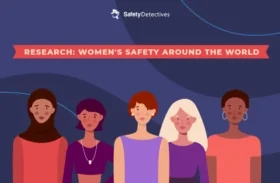|
Getting your Trinity Audio player ready...
|
A global study by SafetyDetectives reveals that male violence against women is widespread, with 80% experiencing sexual harassment and 1 in 3 facing physical or sexual violence. Personal safety is a basic right, yet many women worldwide face daily threats.
The study was conducted to identify the safest and most dangerous countries for women, though results were limited by data accuracy and reporting challenges. Male violence against women remains deeply entrenched in many societies, and while there has been progress in advancing women’s rights and safety, the problem persists in both overt and subtle forms.
Key Findings: Global Study on Women’s Safety
- Prevalence of Violence: A global study reveals that 80% of women experience sexual harassment at some point in their lives, and 1 in 3 face physical or sexual violence. This highlights the widespread nature of gender-based violence across the world.
- Most Dangerous Countries: South Africa and Sweden are ranked as the most dangerous countries for women, based on crime data, while Japan, Poland, and Bosnia and Herzegovina are among the safest. Nigeria is also ranked among the 15 lowest countries in the world in terms of women’s safety, based on a combination of crime rates and the strength of laws protecting women.
- Underreporting of Crimes: The study notes that low crime reports can mask the severity of violence, as seen in some Middle Eastern countries where women face cultural or legal barriers to reporting abuse. Conversely, high reporting rates in countries like Sweden may reflect stronger legal frameworks and trust in authorities.
- Legal Protections: The study also assesses women’s legal rights in 192 countries, finding that legal protections (e.g., laws against domestic violence, workplace discrimination, and reproductive rights) vary widely. Countries with comprehensive legal protections often score well, though enforcement remains a challenge.
- Education and Empowerment: Lack of education, particularly in conflict zones like Afghanistan, leaves women vulnerable to early marriage and abuse. Educated women are better equipped to resist and escape gender-based violence, underscoring the importance of education in enhancing women’s safety and empowerment.
- Case Study – Afghanistan: The return of the Taliban to power has reversed decades of progress for Afghan women, severely restricting their rights to education, employment, and freedom of movement. While some legal protections exist, they are rarely enforced, leaving women vulnerable to violence, including honour killings and forced dependency on male relatives.
- Economic Impact: Restrictions on women’s movement and employment in Afghanistan have led to increased food insecurity and economic dependence on male family members. In some countries, financial insecurity compels women to remain in abusive relationships, as they lack the means to support themselves.
- Global Outrage and Action: The 2021 murder of Sarah Everard and the 2022 death of Mahsa Amini sparked global movements, amplifying the call for systemic changes to protect women. The International Criminal Court (ICC) announced in 2025 that the Taliban’s leader will be held criminally responsible for the ongoing persecution of women and girls.
Additional Findings
- In the U.S., 50% of Native women report being stalked, and 56% experience sexual violence in their lifetime.
- In the EU, 43% of women report experiencing psychological abuse or controlling behaviour from their partners.
While some countries have implemented robust legal protections for women, others, like Afghanistan, show how political regimes and cultural oppression can erase those rights and expose women to ongoing harm. Education plays a critical role in empowering women, as a lack of education significantly increases vulnerability to violence and abuse.
Ultimately, true safety for women depends not only on legal frameworks but also on cultural shifts, effective enforcement, and education to challenge gender-based violence.





